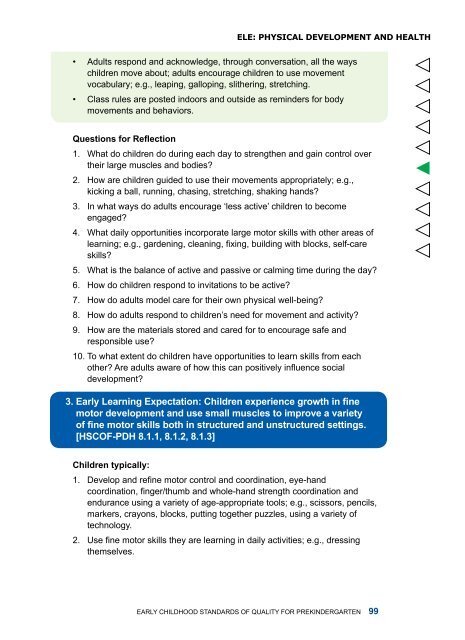Early Childhood Standards of Quality for ... - State of Michigan
Early Childhood Standards of Quality for ... - State of Michigan
Early Childhood Standards of Quality for ... - State of Michigan
You also want an ePaper? Increase the reach of your titles
YUMPU automatically turns print PDFs into web optimized ePapers that Google loves.
ELE: Physical Development and Health• Adults respond and acknowledge, through conversation, all the wayschildren move about; adults encourage children to use movementvocabulary; e.g., leaping, galloping, slithering, stretching.• Class rules are posted indoors and outside as reminders <strong>for</strong> bodymovements and behaviors.Questions <strong>for</strong> Reflection1. What do children do during each day to strengthen and gain control overtheir large muscles and bodies?2. How are children guided to use their movements appropriately; e.g.,kicking a ball, running, chasing, stretching, shaking hands?3. In what ways do adults encourage ‘less active’ children to becomeengaged?4. What daily opportunities incorporate large motor skills with other areas <strong>of</strong>learning; e.g., gardening, cleaning, fixing, building with blocks, self-careskills?5. What is the balance <strong>of</strong> active and passive or calming time during the day?6. How do children respond to invitations to be active?7. How do adults model care <strong>for</strong> their own physical well-being?8. How do adults respond to children’s need <strong>for</strong> movement and activity?9. How are the materials stored and cared <strong>for</strong> to encourage safe andresponsible use?10. To what extent do children have opportunities to learn skills from eachother? Are adults aware <strong>of</strong> how this can positively influence socialdevelopment?3. <strong>Early</strong> Learning Expectation: Children experience growth in finemotor development and use small muscles to improve a variety<strong>of</strong> fine motor skills both in structured and unstructured settings.[HSCOF-PDH 8.1.1, 8.1.2, 8.1.3]Children typically:1. Develop and refine motor control and coordination, eye-handcoordination, finger/thumb and whole-hand strength coordination andendurance using a variety <strong>of</strong> age-appropriate tools; e.g., scissors, pencils,markers, crayons, blocks, putting together puzzles, using a variety <strong>of</strong>technology.2. Use fine motor skills they are learning in daily activities; e.g., dressingthemselves.<strong>Early</strong> <strong>Childhood</strong> <strong>Standards</strong> <strong>of</strong> <strong>Quality</strong> <strong>for</strong> Prekindergarten 99


